Heat Treatment of Flint at the Late Neanderthal Site Sesselfelsgrotte (Germany)
Abstract
1. Introduction
1.1. The Site of Sesselfelsgrotte
1.2. On the Integrity of the Stratigraphic Units
1.3. Regarding the Presence/Absence of Fire and the Climatic Conditions
2. Materials and Methods
Lithic Heat Treatment
3. Results
Additional Evidence for Fire Use in Sesselfelsgrotte
4. Discussion
4.1. Fire Use among the Neanderthals of Sesselfelsgrotte
4.2. Evidence of Heat Treatment and Modern Human Behaviour
5. Conclusions
Author Contributions
Funding
Data Availability Statement
Acknowledgments
Conflicts of Interest
References
- Abdolahzadeh, A.; McPherron, S.P.; Sandgathe, D.M.; Schurr, T.G.; Olszewski, D.I.; Dibble, D.L. Investigating variability in the frequency of fire use in the archaeological record of Late Pleistocene Europe. Archaeol. Anthropol. Sci. 2022, 14, 62. [Google Scholar] [CrossRef]
- Dibble, H.L.; Abdolahzadeh, A.; Aldeias, V.; Goldberg, P.; McPherron, S.; Sandgathe, D.M. How did Hominins adapt to Ice Age Europe without fire. Curr. Anthropol. 2017, 58, 267–278. [Google Scholar] [CrossRef]
- Sandgathe, D.M.; Dibble, H.L.; Goldberg, P.; McPherron, S.P.; Turq, A.; Niven, L.; Hodgkins, J. Timing of the appearance of habitual fire use. Proc. Natl. Acad. Sci. USA 2011, 108, E298. [Google Scholar] [CrossRef] [PubMed]
- Sandgathe, D.M.; Dibble, H.L.; Goldberg, P.; McPherron, S.P.; Turq, A.; Niven, L.; Hodgkins, J. On the role of fire in Neandertal adaptations in Western Europe: Evidence from Pech de l’Azé IV and Roc de Marsal, France. PaleoAnthropology 2011, 216–242. [Google Scholar] [CrossRef]
- Koller, J.; Baumer, U.; Mania, D. High-tech in the Middle Palaeolithic: Neandertal-manufactured pitch identified. Eur. J. Archaeol. 2001, 4, 385–397. [Google Scholar] [CrossRef]
- Mazza, P.P.A.; Martini, F.; Sala, B.; Magi, M.; Colombini, M.P.; Giachi, G.; Landucci, F.; Lemorini, C.; Modugno, F.; Ribechini, E. A new Palaeolithic discovery: Tar-hafted stone tools in a European Mid-Pleistocene bone-bearing bed. J. Archaeol. Sci. 2006, 33, 1310–1318. [Google Scholar] [CrossRef]
- Niekus, M.J.T.; Kozowyk, P.R.; Langejans, G.H.; Ngan-Tillard, D.; van Keulen, H.; van der Plicht, J.; Cohen, K.M.; van Wingerden, W.; van Os, B.; Smit, B.I.; et al. Middle Paleolithic complex technology and a Neandertal tar-backed tool from the Dutch North Sea. Proc. Natl. Acad. Sci. USA 2019, 116, 22081–22087. [Google Scholar] [CrossRef] [PubMed]
- Roebroeks, W.; Villa, P. On the earliest evidence for habitual use of fire in Europe. Proc. Natl. Acad. Sci. USA 2011, 108, 5209–5214. [Google Scholar] [CrossRef]
- Parfitt, S.A.; Barendregt, R.W.; Breda, M.; Candy, I.; Collins, M.J.; Coope, G.R.; Durbidge, P.; Field, M.H.; Lee, J.R.; Lister, A.M.; et al. The earliest record of human activity in northern Europe. Nature 2005, 438, 1008–1012. [Google Scholar] [CrossRef]
- Parfitt, S.A.; Ashton, N.M.; Lewis, S.G.; Abel, R.L.; Coope, G.R.; Field, M.H.; Gale, R.; Hoare, P.G.; Larkin, N.R.; Lewis, M.D.; et al. Early Pleistocene human occupation at the edge of the boreal zone in northwest Europe. Nature 2010, 466, 229–233. [Google Scholar] [CrossRef]
- Berna, F.; Goldberg, P.; Horwitz, L.K.; Brink, J.; Holt, S.; Bamford, M.; Chazan, M. Microstratigraphic evidence of in situ fire in the Acheulean strata of Wonderwerk Cave, Northern Cape province, South Africa. Proc. Natl. Acad. Sci. USA 2012, 109, E1215–E1220. [Google Scholar] [CrossRef]
- Gowlett, J.A.; Harris, J.W.; Walton, D.; Wood, B.A. Early archaeological sites, hominid remains and traces of fire from Chesowanja, Kenya. Nature 1981, 294, 125–129. [Google Scholar] [CrossRef]
- Bellomo, R.V. Methods of determining early hominid behavioral activities associated with the controlled use of fire at FxJj 20 Main, Koobi Fora, Kenya. J. Hum. Evol. 1994, 27, 173–195. [Google Scholar] [CrossRef]
- Hlubik, S.; Cutts, R.; Braun, D.R.; Berna, F.; Feibel, C.S.; Harris, J.W. Hominin fire use in the Okote member at Koobi Fora, Kenya: New evidence for the old debate. J. Hum. Evol. 2019, 133, 214–229. [Google Scholar] [CrossRef]
- Brain, C.K.; Sillent, A. Evidence from the Swartkrans cave for the earliest use of fire. Nature 1988, 336, 464–466. [Google Scholar] [CrossRef]
- Balter, V.; Blichert-Toft, J.; Braga, J.; Telouk, P.; Thackeray, F.; Albarède, F. U–Pb dating of fossil enamel from the Swartkrans Pleistocene hominid site, South Africa. Earth Planet Sci. Lett. 2008, 267, 236–246. [Google Scholar] [CrossRef]
- Alperson-Afil, N. Continual fire-making by hominins at Gesher Benot Ya ‘aqov, Israel. Quat. Sci. Rev. 2008, 27, 1733–1739. [Google Scholar] [CrossRef]
- Alperson-Afil, N.; Goren-Inbar, N. The Acheulian Site of Gesher Benot Ya’aqov Volume II: Ancient Flames and Controlled Use of Fire; Springer Science & Business Media: Berlin/Heidelberg, Germany, 2010. [Google Scholar]
- Zohar, I.; Alperson-Afil, N.; Goren-Inbar, N.; Prévost, M.; Tütken, T.; Sisma-Ventura, G.; Hershkovitz, I.; Najorka, J. Evidence for the cooking of fish 780,000 years ago at Gesher Benot Ya’aqov, Israel. Nat. Ecol. Evol. 2022, 6, 2016–2028. [Google Scholar] [CrossRef]
- Walker, M.J.; Anesin, D.; Angelucci, D.; Avilés-Fernández, A.; Berna, F.; Buitrago-López, A.T.; Carrión, J.S.; Eastham, A.; Fernández-Jalvo, Y.; Fernández-Jiménez, S.; et al. A View from a Cave: Cueva Negra del Estrecho del Río Quípar (Caravaca de la Cruz, Murcia, Southeastern Spain). Reflections on Fire, Technological Diversity, Environmental Exploitation, and Palaeoanthropological Approaches. Hum. Evol. 2016, 31, 1–67. [Google Scholar]
- Barkai, R.; Rosell, J.; Blasco, R.; Gopher, A. Fire for a reason: Barbecue at middle Pleistocene Qesem cave, Israel. Curr. Anthropol. 2017, 58, S314–S328. [Google Scholar] [CrossRef]
- Preece, R.C.; Gowlett, J.A.; Parfitt, S.A.; Bridgland, D.R.; Lewis, S.G. Humans in the Hoxnian: Habitat, context and fire use at Beeches Pit, West Stow, Suffolk, UK. J. Quat. Sci. 2006, 21, 485–496. [Google Scholar] [CrossRef]
- Roebroeks, W.; MacDonald, K.; Scherjon, F.; Gaudzinski-Windheuser, S.; Jöris, O. Establishing patterns of early fire use in human evolution. In The Beef behind All Possible Pasts; Gaudzinski-Windheuser, S., Jöris, O., Eds.; The Tandem Festschrift in Honour of Elaine Turner and Martin Street, Verlag des Römisch-Germanischen Zentralmuseums: Mainz, Germany, 2021; pp. 7–16. [Google Scholar]
- Schmidt, P.; Blessing, M.; Rageot, M.; Iovita, R.; Pfleging, J.; Nickel, K.G.; Righetti, L.; Tennie, C. Birch tar production does not prove Neanderthal behavioral complexity. Proc. Natl. Acad. Sci. USA 2019, 116, 17707–17711. [Google Scholar] [CrossRef] [PubMed]
- Freund, G.; Sesselfelsgrotte, I. Grabungsverlauf und Stratigraphie; Quartär-Bibliothek Band 8; Saarbrücker Druckerei und Verlag: Saarbrücken, Germany, 1998. [Google Scholar]
- Richter, J. For lack of a wise old man? Late Neanderthal land use patterns in the Altmühl River Valley, Southern Germany. In Middle Stone Age and Middle Palaeolithic Settlement Patterns; Universität zu Köln Institut für Ur- und Frühgeschichte: Köln, Germany, 2001; pp. 205–220. [Google Scholar]
- Rathgeber, T. Zur technischen Aufbereitung des Faunenmaterials und Übersicht über die jungpleistozänen Großsäugerfaunen der Sesselfelsgrotte (Neuessing, Niederbayern). In Sesselfelsgrotte VI. Naturwissenschaftliche Untersuchungen; Wirbeltierfauna 1—Mollusken—Vegetation; Freund, G., Richter, J., Eds.; Steiner Verlag: Stuttgart, Germany, 2017; Volume 2014, pp. 13–27. [Google Scholar]
- Richter, J. Sesselfelsgrotte III. Der G-Schichten-Komplex der Sesselfelsgrotte. Zum Verständnis des Micoquien; Quartär-Bibliothek Band 7; Saarbrücker Druckerei und Verlag: Saarbrücken, Germany, 1997. [Google Scholar]
- Richter, J. Die 14C-Daten aus der Sesselfelsgrotte und die Zeitstellung des Micoquien/M.M.O. Germania 2002, 80, 1–22. [Google Scholar]
- Richter, D.; Mauz, B.; Bohner, U.; Weismüller, W.; Wagner, G.A.; Freund, G.; Rink, W.J.; Richter, J. Luminescence dating of the middle/upper Palaeolithic sites ‘Sesselfelsgrotte’ and ‘Abri I Schulerloch’, Altmühltal, Bavaria. In Neanderthals and Modern Humans e Discussing the Transition; Central and Eastern Europe from 50.000–30.000 B.P.; Orschiedt, J., Weniger, C., Eds.; Wissenschaftliche Schriften des Neanderthal Museums: Mettmann, Germany, 2000; Volume 2, pp. 30–41. [Google Scholar]
- Weißmüller, W. Sesselfelsgrotte II. Die Silexartefakte der Unteren Schichten der Sesselfelsgrotte. Ein Beitrag zum Problem des Moustérien; Quartär-Bibliothek, Band 6; Saarbrücker Druckerei und Verlag: Saarbrücken, Germany, 1995. [Google Scholar]
- Rathgeber, T. Fossile Menschenreste aus der Sesselfelsgrotte im unteren Altmühltal (Bayern, Bundesrepublik Deutschland). Quartär 2006, 53–54, 33–59. [Google Scholar]
- Street, M.; Terberger, T.; Orschiedt, J. A critical review of the German Paleolithic hominin record. J. Hum. Evol. 2006, 51, 551–579. [Google Scholar] [CrossRef] [PubMed]
- Böhner, U. Sesselfelsgrotte IV. Die Schicht E3 der Sesselfelsgrotte und die Funde aus dem Abri I am Schulerloch. Späte Micoquien-Inventare und ihre Stellung zum Moustérien: Stuttgart; Germany, 2008. [Google Scholar]
- Knipping, M. Botanische Untersuchungen an Sedimenten der Sesselfelsgrotte (Neuessing, Niederbayern)—Pollen- und Holzkohleanalysen. In Sesselfelsgrotte VII. Naturwissenschaftliche Untersuchungen; Wirbeltierfauna, Teil 2—Mollusken—Vegetation; Freund, G., Richter, J., Eds.; Steiner Verlag: Stuttgart, Germany, 2017; pp. 187–232. [Google Scholar]
- Rathgeber, T. Die frühwürmzeitliche Großfauna der Sesselfelsgrotte (Neuessing, Niederbayern) und die Nutzung des Abris auf der Basis der Knochenfunde (Schichten I bis 3-West). In Sesselfelsgrotte VII. Naturwissenschaftliche Untersuchungen; Wirbeltierfauna 2—Mollusken—Vegetation; Freund, G., Richter, J., Eds.; Steiner Verlag: Stuttgart, Germany, 2017; pp. 31–164. [Google Scholar]
- Van Kolfschoten, T. The smaller mammals from the Late Pleistocene sequence of Sesselfelsgrotte. In Sesselfelsgrotte VI. Naturwissenschaftliche Untersuchungen; Wirbeltierfauna 1; Freund, G., Reisch, L., Eds.; Steiner Verlag: Stuttgart, Germany, 2014; pp. 27–117. [Google Scholar]
- Van den Driesch, A.; Zeiler, J.; Van Kolfschoten, T. Birds in a rockshelter: The Palaeolithic avifauna from the Sesselfelsgrotte (Neuessing, Lower Bavaria). In Sesselfelsgrotte VII. Naturwissenschaftliche Untersuchungen; Wirbeltierfauna, Teil 2—Mollusken—Vegetation; Freund, G., Richter, J., Eds.; Steiner Verlag: Stuttgart, Germany, 2017; pp. 9–29. [Google Scholar]
- Maul, L.C. Leporid remains of the Sesselfelsgrotte (Neuessing, Lower Bavaria). In Sesselfelsgrotte VI. Naturwissenschaftliche Untersuchungen; Wirbeltierfauna 1; Freund, G., Reisch, L., Eds.; Steiner Verlag: Stuttgart, Germany, 2014; pp. 119–139. [Google Scholar]
- Prüfer, O.H. The Abri Schmidt, an important Upper Paleolithic site in Bavaria. Ohio J. Sci. 1961, 61, 45–59. Available online: https://core.ac.uk/download/pdf/76294061.pdf (accessed on 8 February 2022).
- Dirian, A.; Sesselfelsgrotte, V. Das Späte Jungpaläolithikum und das Spätpaläolithikum der Oberen Schichten der Sesselfelsgrotte; Quartär-Bibliothek 9; Saarbrücker Druckerei und Verlag: Saarbrücken, Germany, 2003. [Google Scholar]
- Henry, A.G. Neanderthal cooking and the costs of fire. Curr. Anthropol. 2017, 58, S329–S336. [Google Scholar] [CrossRef]
- Sorensen, A.C. On the relationship between climate and Neandertal fire use during the last glacial in south-west France. Quatern. Int. 2017, 436, 114–128. [Google Scholar] [CrossRef]
- Sorensen, A.C.; Roebroeks, W.; Van Gijn, A. Fire production in the deep past? The expedient strike-a-light model. J. Archaeol. Sci. 2014, 42, 476–486. [Google Scholar] [CrossRef]
- Sorensen, A.C.; Claud, E.; Soressi, M. Neandertal fire-making technology inferred from microwear analysis. Sci. Rep. 2018, 8, 1–10065. [Google Scholar] [CrossRef]
- Dibble, H.L.; McPherron, S.J.P.; Goldberg, P.; Sandgathe, D. The Middle Paleolithic Site of Pech de l’Azé IV; Monograph: Cave and Karst Systems of the World Series; Springer: Berlin/Heidelberg, Germany, 2018; pp. 221–227. [Google Scholar]
- Dibble, H.L.; Sandgathe, D.; Goldberg, P.; McPherron, S.; Aldeias, V. Were Western European Neandertals able to make fire? J. Paleolit. Archaeol. 2018, 1, 54–79. [Google Scholar] [CrossRef]
- Sroubek, P.; Diehl, J.F.; Kadlec, J.; Valoch, K. A Late Pleistocene palaeoclimate record based on mineral magnetic properties of the entrance facies sediments of Kulna Cave, Czech Republic. Geophys. J. Int. 2001, 147, 247–262. [Google Scholar] [CrossRef]
- Higham, T.; Jacobi, R.; Basell, L.; Ramsey, C.B.; Chiotti, L.; Nespoulet, R. Precision dating of the Palaeolithic: A new radiocarbon chronology for the Abri Pataud (France), a key Aurignacian sequence. J. Hum. Evol. 2011, 61, 549–563. [Google Scholar] [CrossRef] [PubMed]
- Bordes, F. A Tale of Two Caves; HarperCollins Publishers: New York, NY, USA, 1972. [Google Scholar]
- Rähle, W. Die Mollusken aus dem Jungpleistozän der Sesselfelsgrotte (Neuessing, Niederbayern) und dem Aufschluss 1999/2000 am Hangfuß unterhalb der Grotte. In Sesselfelsgrotte VI. Naturwissenschaftliche Untersuchungen; Wirbeltierfauna 1—Mollusken—Vegetation; Freund, G., Richter, J., Eds.; Steiner Verlag: Stuttgart, Germany, 2017; Volume 2014, pp. 165–186. [Google Scholar]
- Théry-Parisot, I.; Chabal, L.; Chrzavzez, J. Anthracology and taphonomy, from wood gathering to charcoal analysis. A review of the taphonomic processes modifying charcoal assemblages, in archaeological contexts. Palaeogeogr. Palaeoclimatol. Palaeoecol. 2010, 291, 142–153. [Google Scholar] [CrossRef]
- Alperson-Afil, N. Spatial analysis of fire: Archaeological approach to recognizing early fire. Curr. Anthropol. 2017, 58, 258–277. [Google Scholar] [CrossRef]
- Ahler, S.A. Heat treatment of Knife River flint. Lithic Technol. 1983, 12, 1–8. [Google Scholar] [CrossRef]
- Delage, C.; Sunseri, J. Lithic heat treatment in the late Epipalaeolithic of southern Levant: Critical review of the evidence. Lithic Technol. 2004, 29, 161–173. [Google Scholar] [CrossRef]
- Domanski, M.; Webb, J.A. Effect of heat treatment on siliceous rocks used in prehistoric lithic technology. J. Archaeol. Sci. 1992, 19, 601–614. [Google Scholar] [CrossRef]
- Domański, M.; Webb, J.; Glaisher, R.; Gurba, J.; Libera, J.; Zakościelna, A. Heat treatment of Polish flints. J. Archaeol. Sci. 2009, 36, 1400–1408. [Google Scholar] [CrossRef]
- Olausson, D.S.; Larsson, L. Testing for the presence of thermal pretreatment of flint in the Mesolithic and Neolithic of Sweden. J. Archaeol. Sci. 1982, 9, 275–285. [Google Scholar] [CrossRef]
- Purdy, B.A.; Brooks, H.K. Thermal alteration of silica minerals: An archeological approach. Science 1971, 173, 322–325. [Google Scholar] [CrossRef]
- Roqué-Rosell, J.; Torchy, L.; Roucau, C.; Lea, V.; Colomban, P.; Regert, M.; Binder, D.; Sciau, P. Influence of heat treatment on the physical transformations of flint used by Neolithic societies in the Western Mediterranean. MRS Online Proc. Libr. (OPL) 2011, 1319, mrsf10-1319. [Google Scholar] [CrossRef]
- Yegorov, D.; Marder, O.; Khalaily, H.; Milevski, I.; Rosen, S.A. Heat treated or not heat treated: Archaeological and experimental interpretation of flint assemblage from the Middle Pre-Pottery Neolithic B site of Yiftahel. J. Archaeol. Sci. Rep. 2020, 29, 102090. [Google Scholar] [CrossRef]
- Alperson-Afil, N.; Richter, D.; Goren-Inbar, N. Phantom hearth and the use of fire at Gesher Benot Ya’aqov, Israel. PaleoAnthropology 2007, 7, 1–7. Available online: http://hdl.handle.net/11858/00-001M-0000-000F-FF11-B (accessed on 8 February 2022).
- Dibble, H.L.; Berna, F.; Goldberg, P.; McPherron, S.; Mentzer, S.; Niven, L.; Richter, D.; Sandgathe, D.M.; Tháry-Parisot, I.; Turq, A. A preliminary Report on Pech de I’Azé IV, layer 8 (Middle Paleolithic, France). Paleoanthropol. Soc. 2009, 2009, 182–219. [Google Scholar] [CrossRef]
- Goldberg, P.; Dibble, H.L.; Berna, F.; Sandgathe, D.; McPherron, S.J.P.; Turq, A. New evidence on Neandertal use of fire: Examples from Roc de Marsal and Pech de l’Azé IV. Quatern. Int. 2012, 247, 325–340. [Google Scholar] [CrossRef]
- Shimelmitz, R.; Kuhn, S.L.; Jelinek, A.J.; Ronen, A.; Clark, A.E.; Weinstein-Evron, M. ‘Fire at will’: The emergence of habitual fire use 350,000 years ago. J. Hum. Evol. 2014, 77, 196–203. [Google Scholar] [CrossRef] [PubMed]
- Agam, A.; Azuri, I.; Pinkas, I.; Gopher, A.; Natalio, F. Estimating temperatures of heated Lower Palaeolithic flint artefacts. Nat. Hum. Behav. 2021, 5, 221–228. [Google Scholar] [CrossRef]
- Patterson, L.W. Thermal Damage of Chert. Lithic Technol. 1995, 20, 72–80. [Google Scholar]
- Purdy, B.A. Pyrotechnology: Prehistoric application to Chert material in North America. In The Evolution of the First Fire-Using Industries; Wertime, T.A., Wertime, S.F., Eds.; Smithsonian Institution Press: Washington, DC, USA, 1982; pp. 31–44. [Google Scholar]
- Schmidt, P.; Porraz, G.; Bellot-Gurlet, L.; February, E.; Ligouis, B.; Paris, C.; Texier, P.J.; Parkington, J.E.; Miller, C.E.; Nickel, K.G.; et al. A previously undescribed organic residue sheds light on heat treatment in the Middle Stone Age. J. Hum. Evol. 2015, 85, 22–34. [Google Scholar] [CrossRef]
- Bachellerie, J.; Renard, C.; Schmidt, P. Technical innovations during the recent Solutrean in the southwest of France: Recognition of heat treatment of chert and estimation of heating temperatures based on the example of Le Piage (Lot, France). J. Archaeol. Sci. Rep. 2019, 27, 102001. [Google Scholar] [CrossRef]
- Schmidt, P.; Morala, A. First insights into the technique used for heat treatment of chert at the Solutrean site of Laugerie-haute, France. Archaeometry 2018, 60, 885–897. [Google Scholar] [CrossRef]
- Schmidt, P.; Spinelli Sanchez, O.; Kind, C.J. Stone heat treatment in the Early Mesolithic of southwestern Germany: Interpretation and identification. PLoS ONE 2017, 12, e0188576. [Google Scholar] [CrossRef] [PubMed]
- Schmidt, P.; Masse, S.; Laurent, G.; Slodczyk, A.; Le Bourhis, E.; Perrenoud, C.; Livage, J.; Fröhlich, F. Crystallographic and structural transformations of sedimentary chalcedony in flint upon heat treatment. J. Archaeol. Sci. 2012, 39, 135–144. [Google Scholar] [CrossRef]
- Brown, K.S.; Marean, C.W.; Herries, A.I.; Jacobs, Z.; Tribolo, C.; Braun, D.; Roberts, D.L.; Meyer, M.C.; Bernatchez, J. Fire as an engineering tool of early modern humans. Science 2009, 325, 859–862. [Google Scholar] [CrossRef] [PubMed]
- Nickel, K.G.; Schmidt, P. Knapping force as a function of stone heat treatment. PLoS ONE 2022, 17, e0278643. [Google Scholar] [CrossRef]
- Schmidt, P.; Paris, C.; Bellot-Gurlet, L. The investment in time needed for heat treatment of flint and chert. Archaeol. Anthropol. Sci. 2016, 8, 839–848. [Google Scholar] [CrossRef]
- Holyoke, K.R.; Blair, S.E.; Shaw, C.S. Aesthetics or function in heat-treating? The influence of colour preference in lithic preparation on the Maritime Peninsula, Eastern Canada. J. Anthropol. Archaeol. 2020, 60, 101229. [Google Scholar] [CrossRef]
- Moník, M.; Nerudová, Z.; Schnabl, P. Investigation of heat-treated artefacts from Pleistocene sites. J. Archaeol. Sci. Rep. 2021, 37, 102920. [Google Scholar] [CrossRef]
- Weiner, S.; Brumfeld, V.; Marder, O.; Barzilai, O. Heating of flint debitage from Upper Palaeolithic contexts at Manot Cave, Israel: Changes in atomic organization due to heating using infrared spectroscopy. J. Archaeol. Sci. 2015, 54, 45–53. [Google Scholar] [CrossRef]
- Schmidt, P.; Léa, V.; Sciau, P.; Fröhlich, F. Detecting and quantifying heat treatment of flint and other silica rocks: A new non-destructive method applied to heat-treated flint from the Neolithic Chassey culture, Southern France. Archaeometry 2013, 55, 794–805. [Google Scholar] [CrossRef]
- Domanski, M.; Webb, J. A review of heat treatment research. Lithic Technol. 2007, 32, 153–194. [Google Scholar] [CrossRef]
- Mercieca, A.; Hiscock, P. Experimental insights into alternative strategies of lithic heat treatment. J. Archaeol. Sci. 2008, 35, 2634–2639. [Google Scholar] [CrossRef]
- Hanckel, M. Hot rocks: Heat treatment at Burrill Lake and Currarong, New South Wales. Archaeol. Ocean. 1985, 20, 98–103. [Google Scholar] [CrossRef]
- Johnson, L.L.; Behm, J.A.; Bordes, F.; Cahen, D.; Crabtree, D.E.; Dincauze, D.F.; Hay, C.A.; Hayden, B.; Hester, T.R.; Katz, P.R.; et al. A history of flint-knapping experimentation, 1838–1976 [and comments and reply]. Curr. Anthropol. 1978, 19, 337–372. [Google Scholar] [CrossRef]
- Whittaker, J.C. Flintknapping: Making and Understanding Stone Tools; University of Texas Press: Austin, TX, USA, 1994. [Google Scholar]
- Zhou, Z.; Guan, Y.; Gao, X.; Wang, C. Heat treatment and associated early modern human behaviors in the Late Paleolithic at the Shuidonggou site. Chin. Sci. Bull. 2013, 58, 1801–1810. [Google Scholar] [CrossRef][Green Version]
- Santaniello, F.; Grimaldi, S.; Pedrotti, A.; Gialanella, S. First evidence of heat treatment during the early Neolithic in northeastern Italy. Quatern. Int. 2016, 402, 80–89. [Google Scholar] [CrossRef]
- Murray, J.K.; Harris, J.A.; Oestmo, S.; Martin, M.; Marean, C.W. A new approach to identify heat treated silcrete near Pinnacle Point, South Africa using 3D microscopy and Bayesian modeling. J. Archaeol. Sci. Rep. 2020, 34, 102622. [Google Scholar] [CrossRef]
- Schmidt, P.; Porraz, G.; Slodczyk, A.; Bellot-Gurlet, L.; Archer, W.; Miller, C.E. Heat treatment in the South African Middle Stone Age: Temperature induced transformations of silcrete and their technological implications. J. Archaeol. Sci. 2013, 40, 3519–3531. [Google Scholar] [CrossRef]
- Rots, V. The functional analysis of the Mousterian and Micoquian assemblages of Sesselfelsgrotte, Germany: Aspects of tool use and hafting in the European Late Middle Palaeolithic: Funktionsanalysen der Moustérien-und Micoquien-Inventare der Sesselfelsgrotte, Deutschland: Ein Beitrag zu Werkzeuggebrauch und Schäftung im späten Mittelpaläolithikum Europas. Quartär–Int. Jahrb. Erforsch. Eiszeitalt. Steinzeit 2009, 56, 37–66. [Google Scholar]
- Agam, A.; Zupancich, A. Interpreting the Quina and demi-Quina scrapers from Acheulo-Yabrudian Qesem Cave, Israel: Results of raw materials and functional analyses. J. Hum. Evol. 2020, 144, 102798. [Google Scholar] [CrossRef] [PubMed]
- Doronichev, V.B. The Lower Paleolithic in Eastern Europe and the Caucasus: A reappraisal of the data and new approaches. Paleoanthropology 2008, 2008, 107–157. Available online: https://www.researchgate.net/publication/259452214_The_Lower_Paleolithic_in_Eastern_Europe_and_the_Caucasus_A_Reappraisal_of_the_Data_and_New_Approaches?enrichId=rgreq-3bcc958c600122244eaf6e0f406c8bf4-XXX&enrichSource=Y292ZXJQYWdlOzI1OTQ1MjIxNDtBUzoxMDQ4MTQ5NTY1MTUzMzlAMTQwMjAwMTI0MTg5Mg%3D%3D&el=1_x_2&_esc=publicationCoverPdf (accessed on 8 February 2022).
- Solodenko, N.; Zupancich, A.; Cesaro, S.N.; Marder, O.; Lemorini, C.; Barkai, R. Fat residue and use-wear found on Acheulian biface and scraper associated with butchered elephant remains at the site of Revadim, Israel. PLoS ONE 2015, 10, e0118572. [Google Scholar] [CrossRef] [PubMed]
- Bisson, M.S. Interview with a Neanderthal: An experimental approach for reconstructing scraper production rules, and their implications for imposed form in Middle Palaeolithic tools. Camb. Archaeol. J. 2001, 11, 165–184. [Google Scholar] [CrossRef]
- Golovanova, L.V.; Doronicheva, E.V.; Doronichev, V.B.; Shirobokov, I.G. Bifacial scraper-knives in the Micoquian sites in the North-Western Caucasus: Typology, technology, and reduction. Quatern. Int. 2017, 428, 49–65. [Google Scholar] [CrossRef]
- Hardy, B.L. Neanderthal behaviour and stone tool function at the Middle Palaeolithic site of La Quina, France. Antiquity 2004, 78, 547–565. [Google Scholar] [CrossRef]
- Wiśniewski, A.; Lauer, T.; Chłoń, M.; Pyżewicz, K.; Weiss, M.; Badura, J.; Kalicki, T.; Zarzecka-Szubińska, K. Looking for provisioning places of shaped tools of the late Neanderthals: A study of a Micoquian open-air site, Pietraszyn 49a (southwestern Poland). Comptes Rendus Palevol 2019, 18, 367–389. [Google Scholar] [CrossRef]
- Cristiani, E.; Lemorini, C.; Martini, F.; Sarti, L. Scrapers of Callista chione from Grotta del Cavallo (Middle Palaeolithic cave in Apulia): Evaluating use-wear potential. In From Hooves to Horns, from Mollusc to Mammoth e Manufacture and Use of Bone Artefacts from Prehistoric Times to the Present, Proceedings of the 4th Meeting of the ICAZ Worked Bone Research Group at Tallinn, Tallinn, Estonia, 26–31 August 2003; Luik, H., Choyke, A.M., Batey, C., Lougas, L., Eds.; Eraul, Université De Liège: Liege, Belgium, 2005; pp. 319–324. [Google Scholar]
- Giria, E.Y. A use-wear analysis of some Middle Paleolithic flint artifacts from Buran-Kaya III level B. In The Middle Paleolithic and Early Upper Paleolithic of Eastern Crimea; ERAUL: Liege, Belgium, 2004; Volume 104, pp. 151–174. [Google Scholar]
- Lazuén, T.; González-Urquijo, J. Recycling in the Early Middle Paleolithic: The role of resharpening flakes assessed through techno-functional analysis. Quatern. Int. 2015, 361, 229–237. [Google Scholar] [CrossRef]
- Binford, L.R. Smudge pits and hide smoking: The use of analogy in archaeological reasoning. Am. Antiq. 1967, 32, 1–12. [Google Scholar] [CrossRef]
- Keeley, L.H. Hunter-gatherer economic complexity and “population pressure”: A cross-cultural analysis. J Anthropol Archaeol 1988, 7, 373–411. [Google Scholar] [CrossRef]
- Ingold, T. The Perception of the Environment: Essays on Livelihood, Dwelling and Skill; Psychology Press: London, UK, 2000. [Google Scholar]
- Manhire, A.H.; Parkington, J.E.; Mazel, A.D. Cattle, Sheep and Horses: A Review of Domestic Animals in the Rock Art of Southern Africa; Goodwin Series; South African Archaeological Society: Cape Town, South Africa, 1986; pp. 22–30. [Google Scholar]
- Potapov, L.P. Shaman’s drum: A unique monument of spiritual culture of the altai turk peoples. Anthropol. Conscious 1999, 10, 24–35. [Google Scholar] [CrossRef]
- Thackeray, J.F. Eland, hunters and concepts of ‘sympathetic control’: Expressed in southern African rock art. Camb. Archaeol. J. 2005, 15, 27–34. [Google Scholar] [CrossRef]
- Goldberg, P.; Miller, C.E.; Mentzer, S.M. Recognizing fire in the Paleolithic archaeological record. Curr. Anthropol. 2017, 58, S175–S190. [Google Scholar] [CrossRef]
- Mentzer, S.M. Microarchaeological approaches to the identification and interpretation of combustion features in prehistoric archaeological sites. J. Archaeol. Method Theory 2014, 21, 616–668. [Google Scholar] [CrossRef]
- Uthmeier, T.; Chabai, V. Formation processes at sites with high-resolution sequences in the Crimean Middle Paleolithic: The Kabazi V rock shelter and the open-air site of Kabazi II compared. Quatern. Int. 2018, 485, 44–67. [Google Scholar] [CrossRef]
- Shahack-Gross, R.; Bar-Yosef, O.; Weiner, S. Black-coloured bones in Hayonim Cave, Israel: Differentiating between burning and oxide staining. J. Archaeol. Sci. 1997, 24, 439–446. [Google Scholar] [CrossRef]
- Costamagno, S.; Thery-Parisot, I.; Brugal, J.P.; Guibert, R. Taphonomic consequences of the use of bones as fuel. Experimental data and archaeological applications. In Biosphere to Lithosphere: New Studies in Vertebrate Taphonomy; Oxbow Books: Oxford, UK, 2005; pp. 51–62. [Google Scholar]
- Théry-Parisot, I. Fuel management (bone and wood) during the Lower Aurignacian in the Pataud rock shelter (Lower Palaeolithic, Les Eyzies de Tayac, Dordogne, France). Contribution of experimentation. J. Archaeol. Sci. 2002, 29, 1415–1421. [Google Scholar] [CrossRef]
- Aranguren, B.; Revedin, A.; Amico, N.; Cavulli, F.; Giachi, G.; Grimaldi, S.; Macchioni, N.; Santaniello, F. Wooden tools and fire technology in the early Neanderthal site of Poggetti Vecchi (Italy). Proc. Natl. Acad. Sci. USA 2018, 115, 2054–2059. [Google Scholar] [CrossRef]
- Mellars, P. The impossible coincidence. A single-species model for the origins of modern human behavior in Europe. Evol. Anthropol. 2005, 14, 12–27. [Google Scholar] [CrossRef]
- Powell, A.; Shennan, S.; Thomas, M.G. Late Pleistocene demography and the appearance of modern human behavior. Science 2009, 324, 1298–1301. [Google Scholar] [CrossRef]
- Shea, J.J. Homo sapiens is as Homo sapiens was: Behavioral variability versus “behavioral modernity” in Paleolithic archaeology. Curr. Anthropol. 2011, 52, 1–35. [Google Scholar] [CrossRef]
- Breyl, M. Triangulating Neanderthal cognition: A tale of not seeing the forest for the trees. Wiley Interdiscip. Rev. Cogn. Sci. 2021, 12, e1545. [Google Scholar] [CrossRef] [PubMed]
- Nowell, A. Defining behavioral modernity in the context of Neandertal and anatomically modern human populations. Annu. Rev. Anthropol. 2010, 39, 437–452. [Google Scholar] [CrossRef]
- d’Errico, F.; Henshilwood, C.; Vanhaeren, M.; Van Niekerk, K. Nassarius kraussianus shell beads from Blombos Cave: Evidence for symbolic behaviour in the Middle Stone Age. J. Hum. Evol. 2005, 48, 3–24. [Google Scholar] [CrossRef] [PubMed]
- Henshilwood, C.S.; d’Errico, F.; Yates, R.; Jacobs, Z.; Tribolo, C.; Duller, G.A.; Mercier, N.; Sealy, J.C.; Valladas, H.; Watts, I.; et al. Emergence of modern human behavior: Middle Stone Age engravings from South Africa. Science 2002, 295, 1278–1280. [Google Scholar] [CrossRef] [PubMed]
- Marean, C.W.; Bar-Matthews, M.; Bernatchez, J.; Fisher, E.; Goldberg, P.; Herries, A.I.R.; Jacobs, Z.; Jerardino, A.; Karkanas, P.; Minichillo, T.; et al. Early human use of marine resources and pigment in South Africa during the Middle Pleistocene. Nature 2007, 449, 905–908. [Google Scholar] [CrossRef]
- Finlayson, C. The Smart Neanderthal: Bird Catching, Cave Art, and the Cognitive Revolution; Oxford University Press: Oxford, UK, 2019. [Google Scholar]
- Hoffmann, D.L.; Standish, C.D.; García-Diez, M.; Pettitt, P.B.; Milton, J.A.; Zilhão, J.; Alcolea-González, J.J.; Cantalejo-Duarte, P.; Collado, H.; De Balbín, R.; et al. U-Th dating of carbonate crusts reveals Neandertal origin of Iberian cave art. Science 2018, 359, 912–915. [Google Scholar] [CrossRef]
- Roebroeks, W.; Sier, M.J.; Nielsen, T.K.; De Loecker, D.; Parés, J.M.; Arps, C.E.; Mücher, H.J. Use of red ochre by early Neandertals. Proc. Natl. Acad. Sci. USA 2012, 109, 1889–1894. [Google Scholar] [CrossRef]
- Soressi, M.; McPherron, S.P.; Lenoir, M.; Dogandžić, T.; Goldberg, P.; Jacobs, Z.; Maigrot, Y.; Martisius, N.L.; Miller, C.E.; Rendu, W.; et al. Neandertals made the first specialized bone tools in Europe. Proc. Natl. Acad. Sci. USA 2013, 110, 14186–14190. [Google Scholar] [CrossRef]
- Agam, A. Late Lower Paleolithic Lithic Procurement and Exploitation Strategies: A View from Acheulo-Yabrudian Qesem Cave (Israel). J. Archaeol. Sci. Rep. 2020, 33, 102447. [Google Scholar] [CrossRef]
- Rabinovich, R.; Ackermann, O.; Aladjem, E.; Barkai, R.; Biton, R.; Milevski, I.; Solodenko, N.; Marder, O. Elephants at the Middle Pleistocene Acheulian open-air site of Revadim Quarry, Israel. Quatern. Int. 2012, 276–277, 183–197. [Google Scholar] [CrossRef]
- Delagnes, A.; Schmidt, P.; Douze, K.; Wurz, S.; Bellot-Gurlet, L.; Conard, N.J.; Nickel, K.G.; van Niekerk, K.L.; Henshilwood, C.S. Early evidence for the extensive heat treatment of silcrete in the Howiesons Poort at Klipdrift Shelter (Layer PBD, 65 ka), South Africa. PLoS ONE 2016, 11, e0163874. [Google Scholar] [CrossRef] [PubMed]
- Théry-Parisot, I.; Meignen, L. Économie des combustibles (bois et lignite) dans l’abri moustérien des Canalettes: L’expérimentation à la simulation des besoins énergétiques. Gall. Préhistoire–Archéologie Fr. Préhistorique 2000, 42, 45–55. [Google Scholar] [CrossRef]
- Abrams, G.; Bello, S.M.; Di Modica, K.; Pirson, S.; Bonjean, D. When Neanderthals used cave bear (Ursus spelaeus) remains: Bone retouchers from unit 5 of Scladina Cave (Belgium). Quatern. Int. 2014, 326, 274–287. [Google Scholar] [CrossRef]
- Alperson-Afil, N.; Sharon, G.; Kislev, M.; Melamed, Y.; Zohar, I.; Ashkenazi, S.; Rabinovich, R.; Biton, R.; Weker, E.; Hartman, G.; et al. Spatial organization of hominin activities at Gesher Benot Ya’aqov, Israel. Science 2009, 326, 1677–1680. [Google Scholar] [CrossRef] [PubMed]
- Mellars, P. Neanderthal symbolism and ornament manufacture: The bursting of a bubble? Proc. Natl. Acad. Sci. USA 2010, 107, 20147–20148. [Google Scholar] [CrossRef] [PubMed]
- McBrearty, S.; Brooks, A.S. The revolution that wasn’t: A new interpretation of the origin of modern human behavior. J. Hum. Evol. 2000, 39, 453–563. [Google Scholar] [CrossRef]
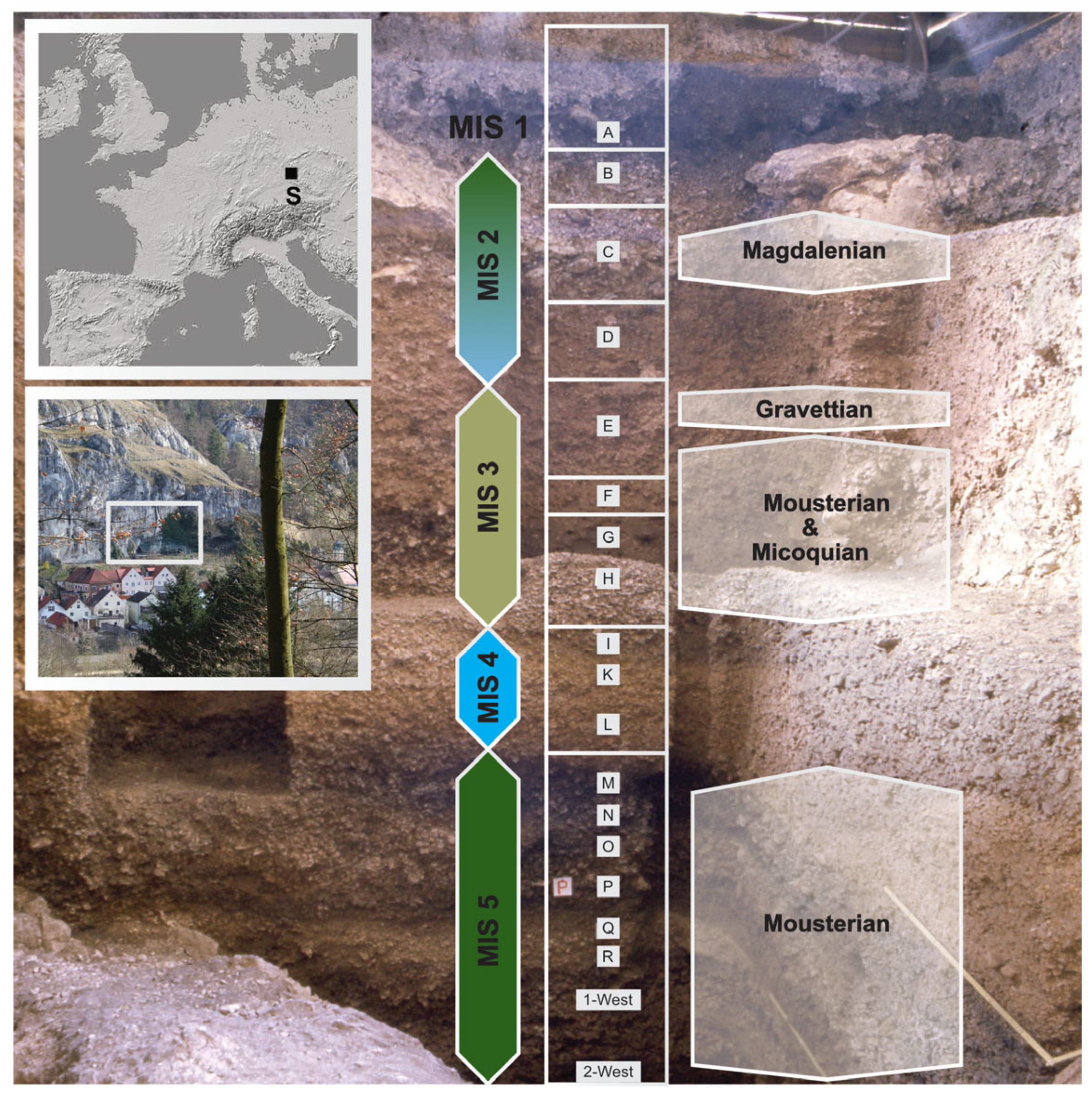
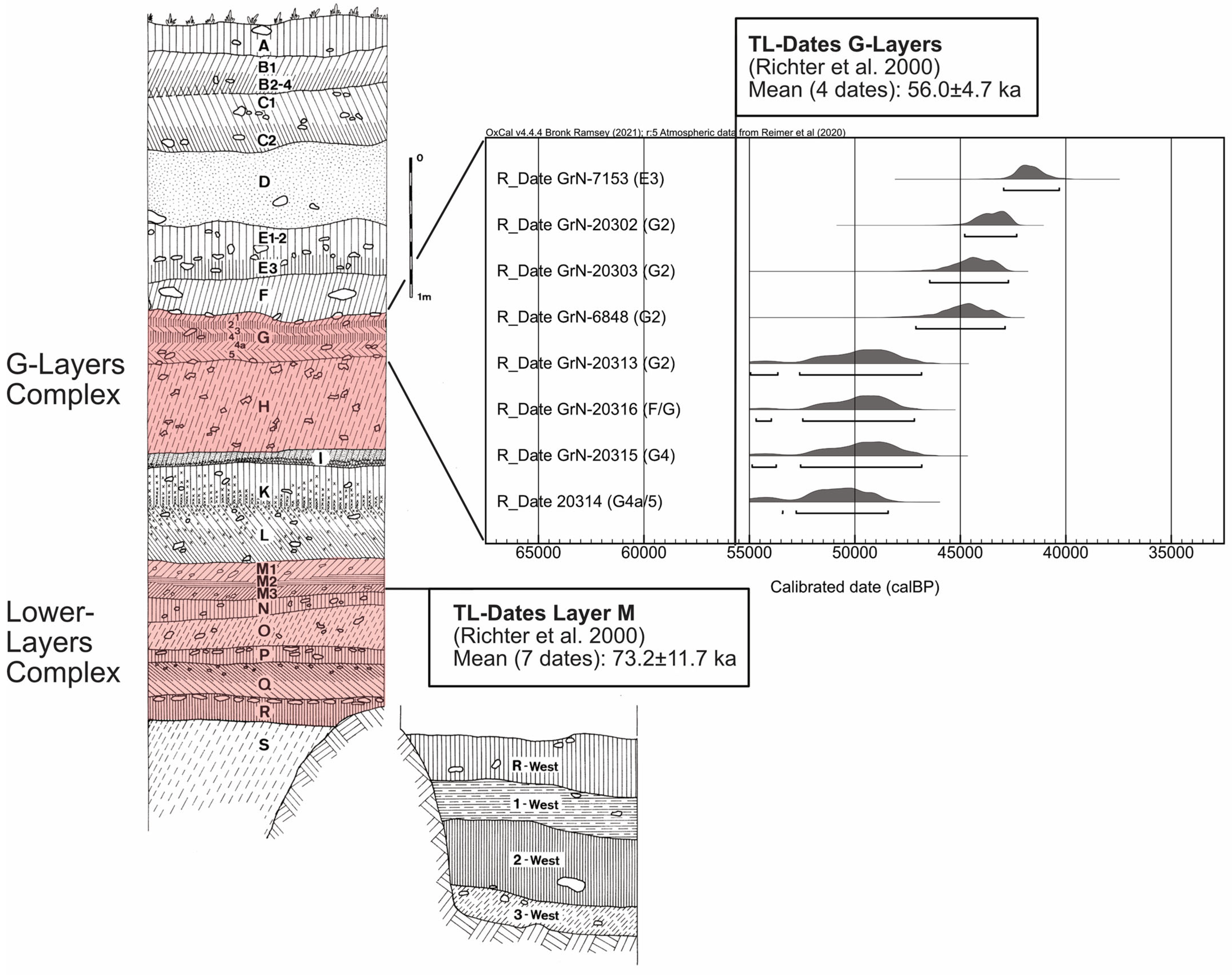
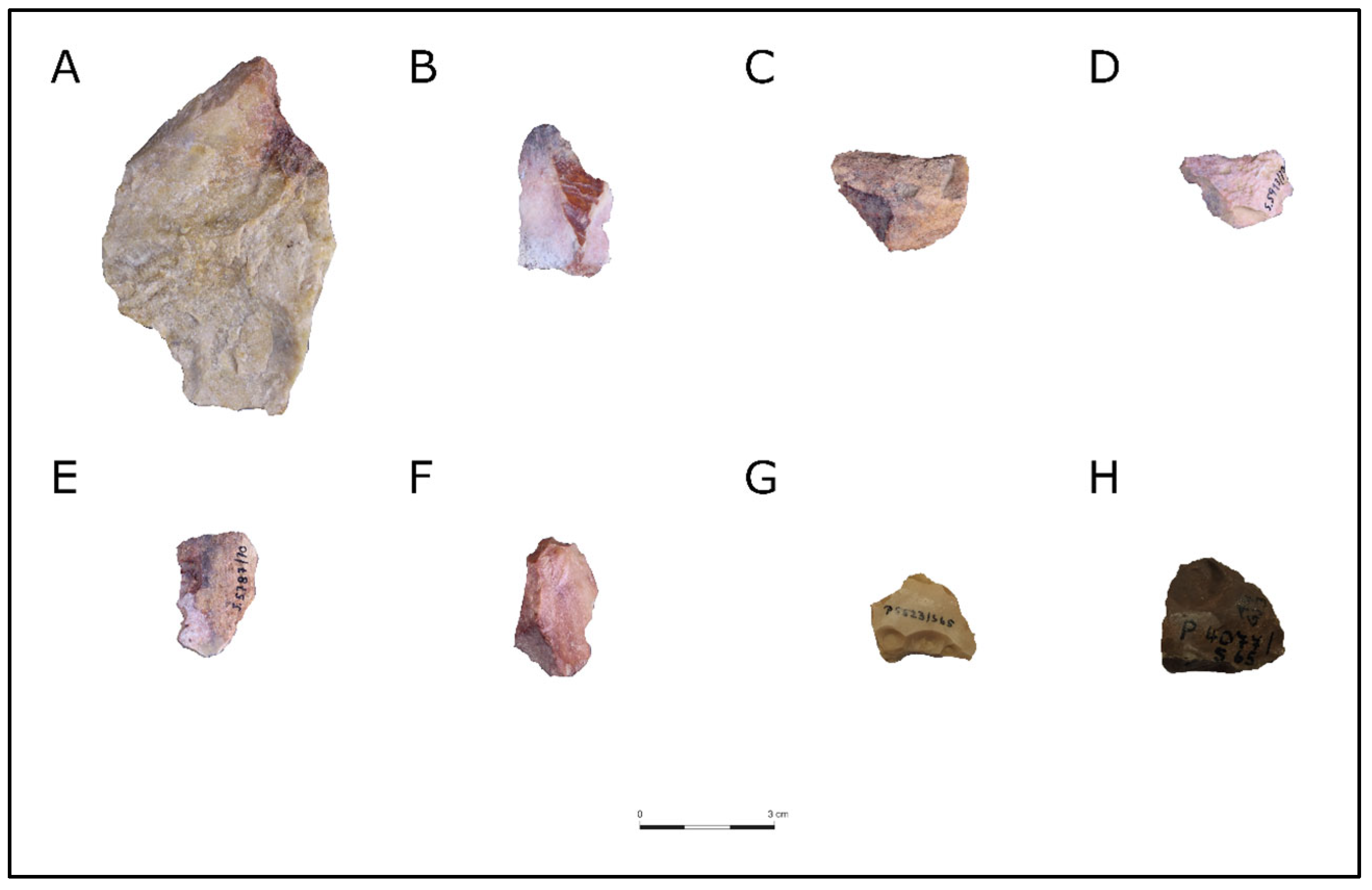
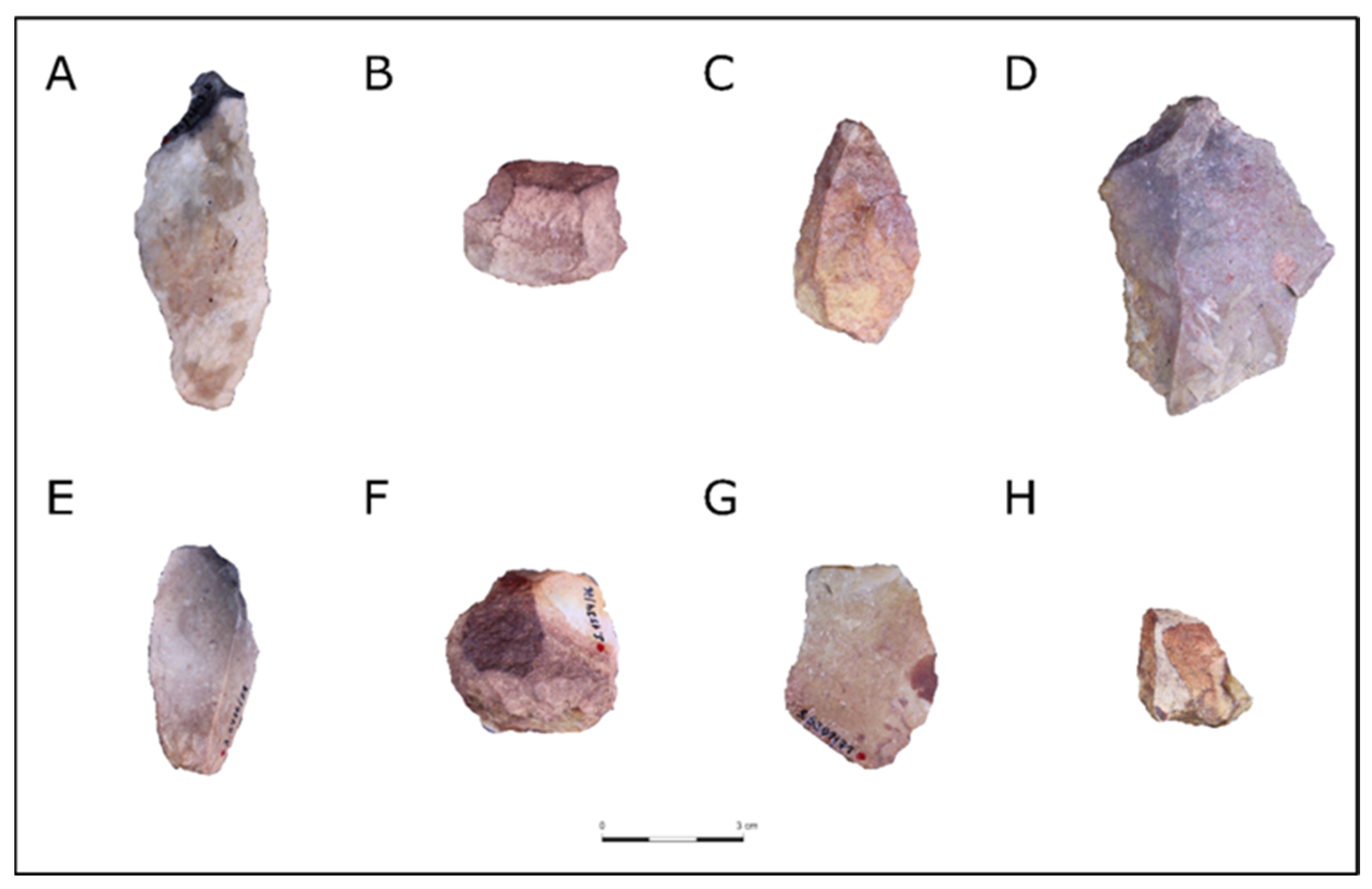
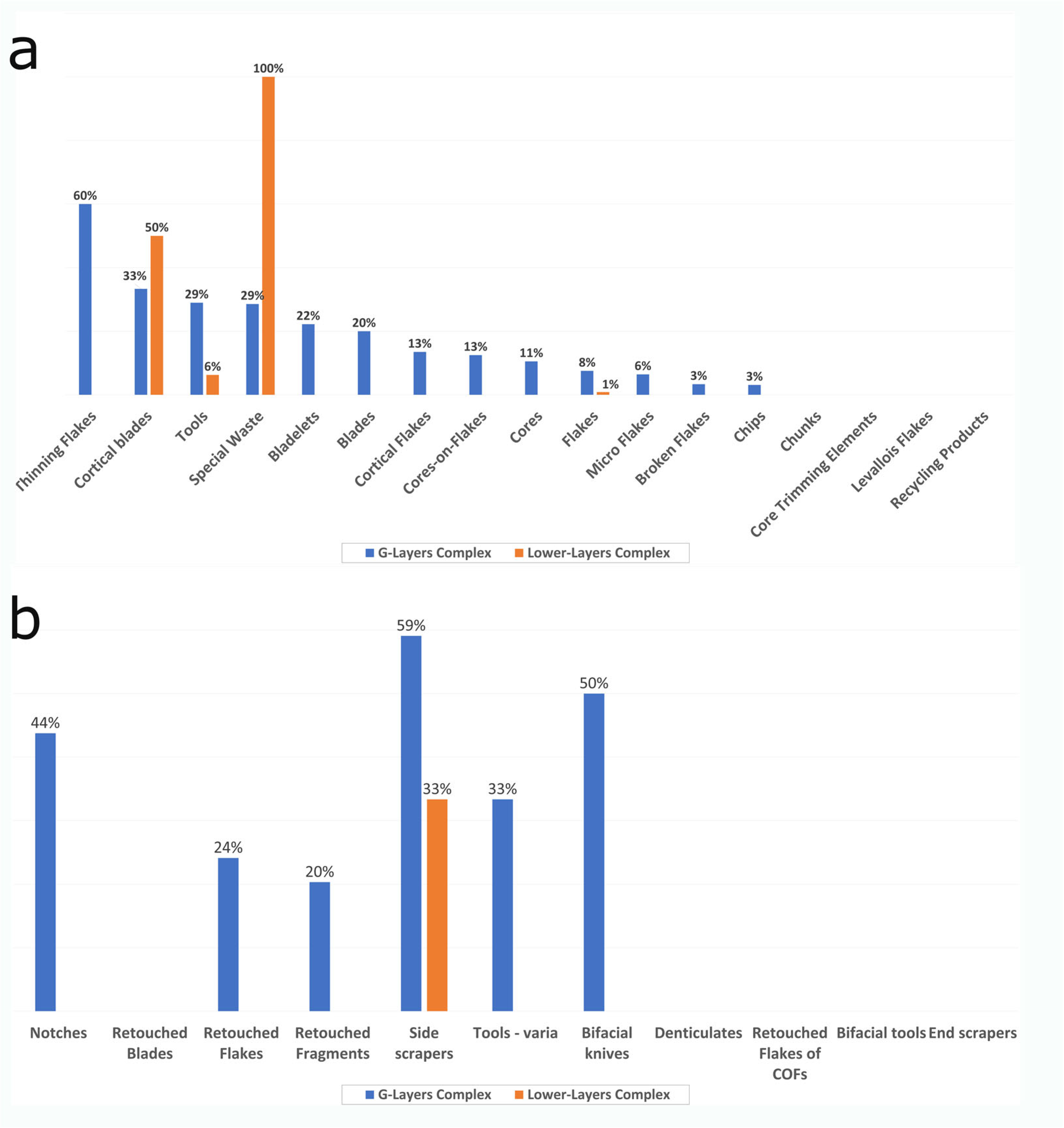
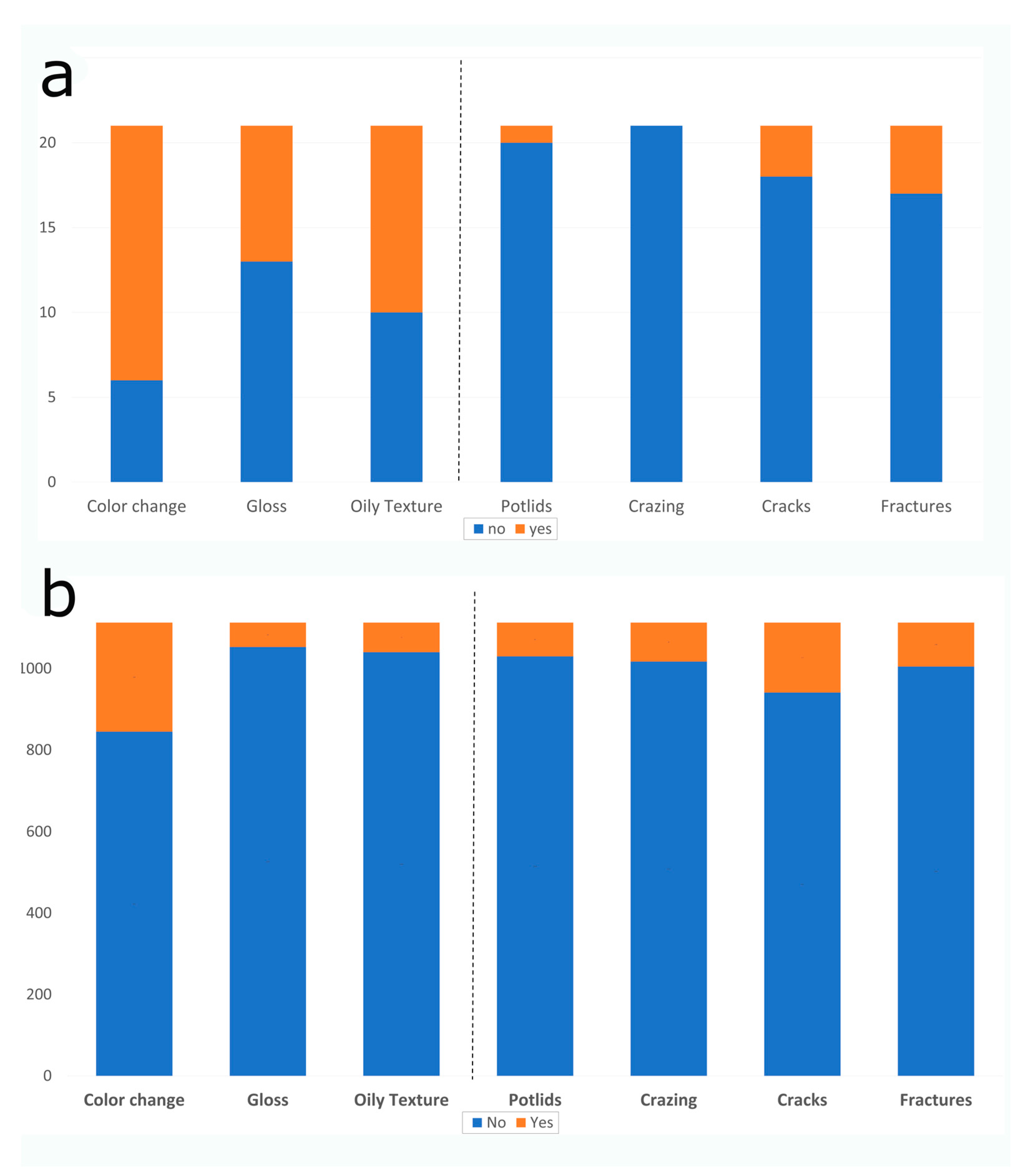

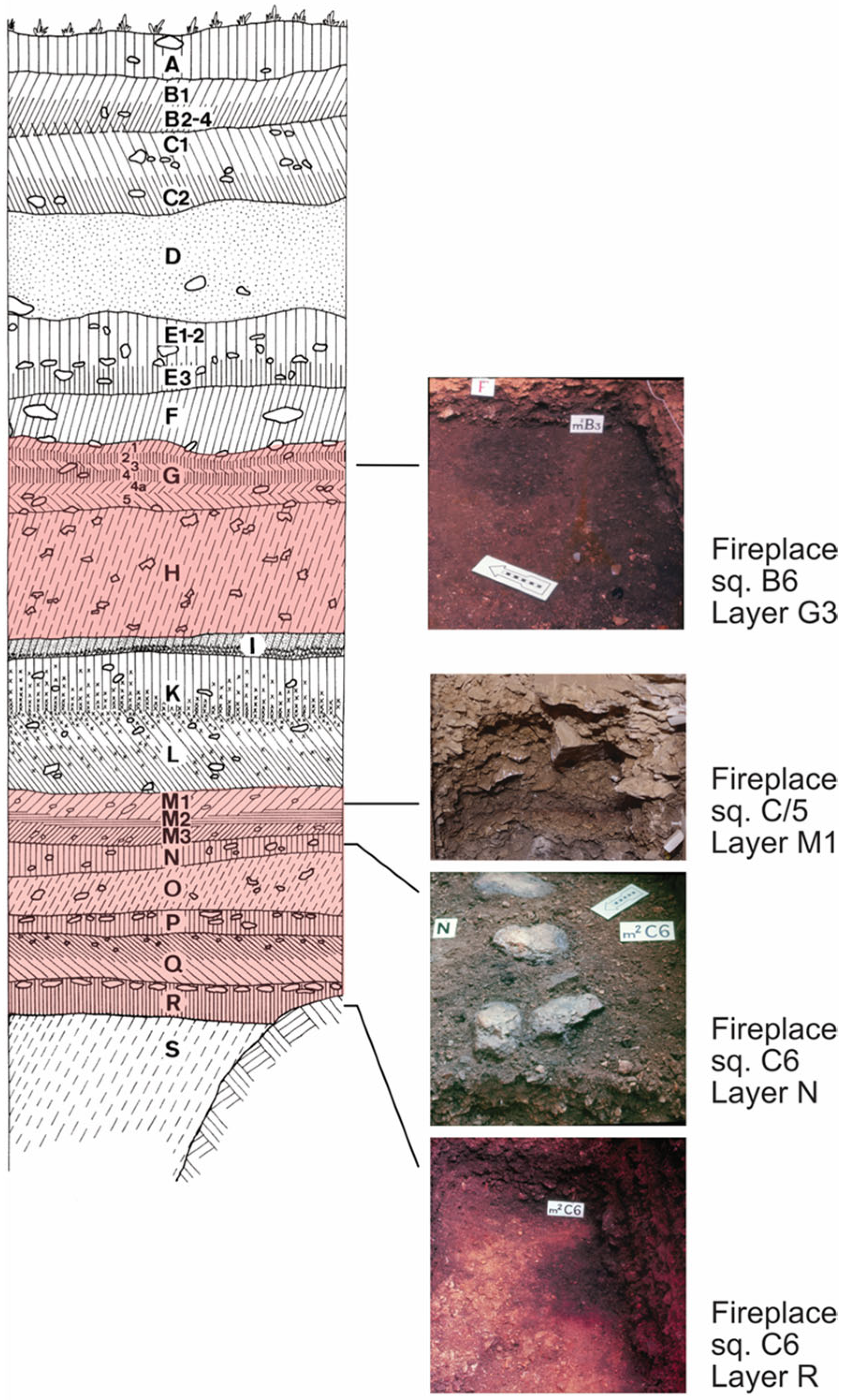
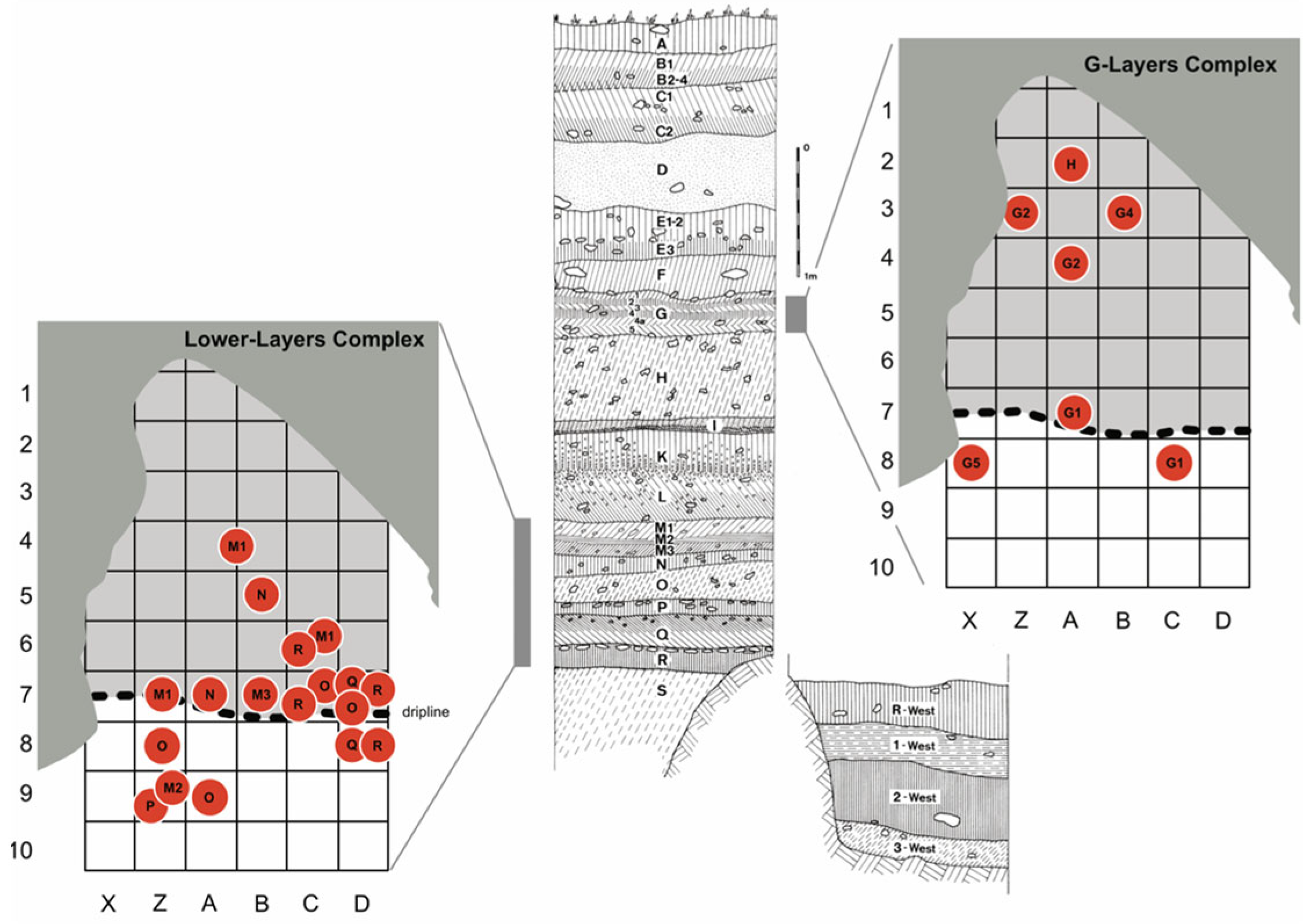
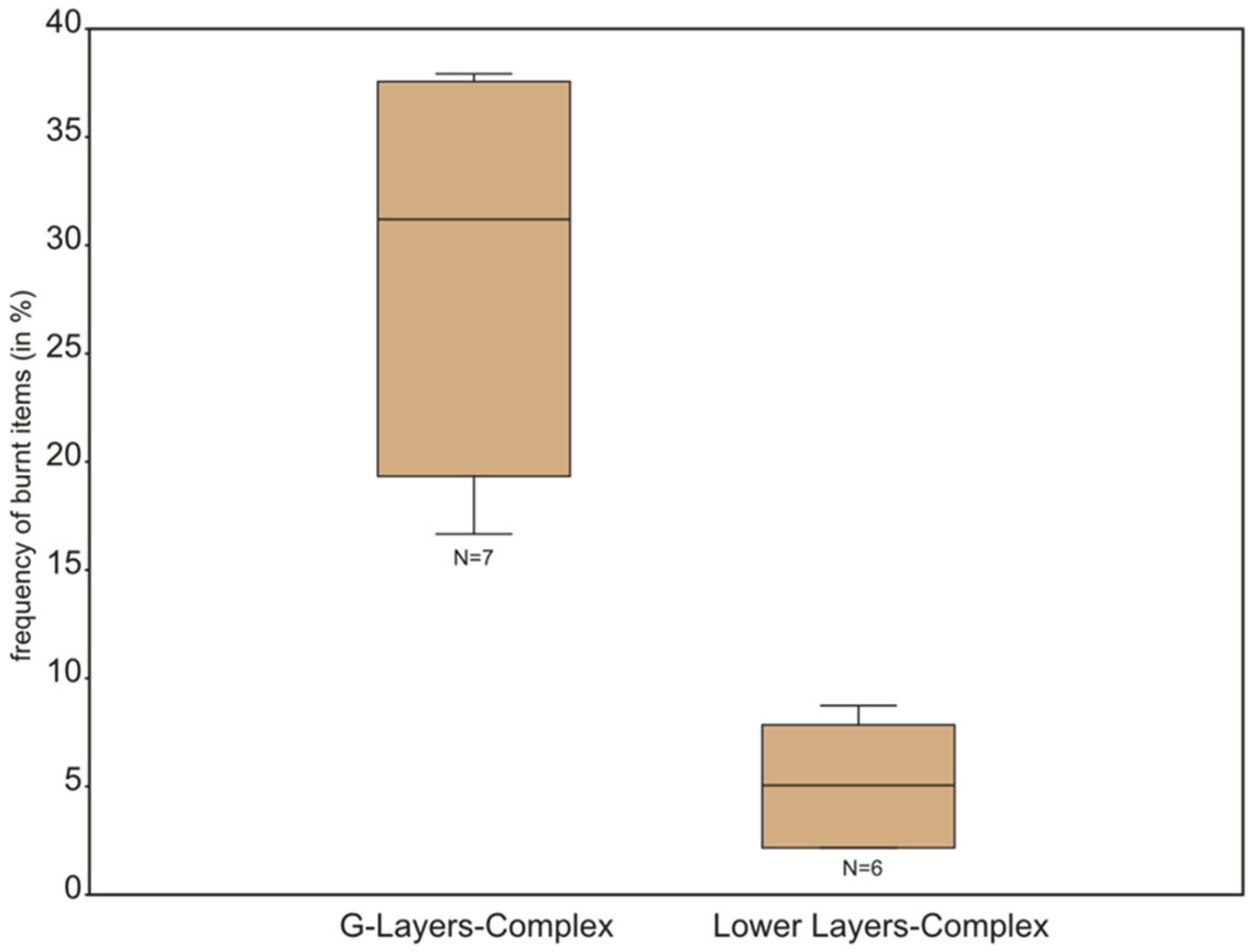
| Lower-Layer Complex | G-Layer Complex | Lower-Layer Complex | G-Layer Complex | |
|---|---|---|---|---|
| Burnt | 285 | 296 | 30.1% | 26.6% |
| Possibly intentionally heated | 8 | 127 | 0.8% | 11.4% |
| Total of Artifacts Altered by fire | 293 | 423 | 30.9% | 38.0% |
| Unburnt | 653 | 690 | 69.0% | 62.0% |
| Grand Total | 946 | 1113 | 100% | 100% |
| Category | Possibly Intentionally Heated | Not Heated | Total | % of Possibly Heated |
|---|---|---|---|---|
| Flakes | 29 | 356 | 385 | 7.5% |
| Tools | 62 | 152 | 214 | 29.0% |
| Broken Flakes | 5 | 144 | 149 | 3.4% |
| Chips | 3 | 93 | 96 | 3.1% |
| Cortical flakes | 12 | 77 | 89 | 13.5% |
| Micro Flakes | 4 | 58 | 62 | 6.5% |
| Debris | - | 49 | 49 | 0.0% |
| Cores | 2 | 17 | 19 | 10.5% |
| Core Trimming Elements | - | 10 | 10 | 0.0% |
| Bladelets | 2 | 7 | 9 | 22.2% |
| Cores-on-Flakes | 1 | 7 | 8 | 12.5% |
| Special Waste | 2 | 5 | 7 | 28.6% |
| Thinning Flakes | 3 | 2 | 5 | 60.0% |
| Blades | 1 | 4 | 5 | 20.0% |
| Cortical Blades | 1 | 2 | 3 | 33.3% |
| Levallois Flake | - | 2 | 2 | 0.0% |
| Recycling Products | - | 1 | 1 | 0.0% |
| Grand Total | 127 | 986 | 1113 | 11.4% |
| Debitage only | 115 | 642 | 757 | 15.2% |
| Side Scraper Type | Possibly Intentionally Heated | Burnt | Unburnt | Total | % of Possibly Heated |
|---|---|---|---|---|---|
| Convex scrapers | 8 | 5 | 13 | 61.5% | |
| Double scrapers | 2 | 2 | 100.0% | ||
| Straight scrapers | 1 | 1 | 2 | 0.0% | |
| Transversal scrapers | 1 | 1 | 0.0% | ||
| Convergent scrapers | 1 | 1 | 0.0% | ||
| Concave scrapers | 1 | 1 | 100.0% | ||
| Angle scrapers | 1 | 1 | 100.0% | ||
| Total | 12 | 6 | 3 | 21 | 57.1% |
| Category | Possibly Intentionally Heated | Not Heated | Total | % of Possibly Heated |
|---|---|---|---|---|
| Flakes | 3 | 336 | 339 | 0.9% |
| Broken Flakes | - | 146 | 146 | 0.0% |
| Chips | - | 121 | 121 | 0.0% |
| Micro Flakes | - | 110 | 110 | 0.0% |
| Debris | - | 80 | 80 | 0.0% |
| Cortical Flakes | - | 78 | 78 | 0.0% |
| Tools | 3 | 45 | 48 | 6.3% |
| Cores | - | 10 | 10 | 0.0% |
| Recycling Products | - | 4 | 4 | 0.0% |
| Core Trimming Elements | - | 3 | 3 | 0.0% |
| Cortical Blades | 1 | 1 | 2 | 50.0% |
| Cores-on-Flakes | - | 1 | 1 | 0.0% |
| Bladelets | - | 1 | 1 | 0.0% |
| Blades | - | 1 | 1 | 0.0% |
| Grand Total | 8 | 938 | 946 | 0.8% |
| Debitage only | 8 | 481 | 489 | 1.6% |
| MIS | Layer | Thickness and Preservation | Sedimentological Features Indicating Fire Use | Features Related to Burning * | Dominant Remains of Fuel |
|---|---|---|---|---|---|
| MIS 3 | G1 | (1) 1 to 4 cm, in part up to 10 cm; original occupation surface (“sol d’habitat”) | High content of anthropogenetic matter, darker color caused by burnt bones. | (2) feature sq. A7: grayish-black concentration of ash (2) feature sq. C8: three small concentrations of burnt bones | Bone |
| G2 | (1) 10 cm (but in most areas further differentiated into G2 oben, G2 Mitte, G2 unten), original occupation surface (“sol d´habitat”) | (1) Black-grey color, ash/soot (“stark aschige Bestandteile”), high content of burnt bones; in some square meters, high content of charcoal. | (2) feature sq. A4: round concentration of ash with a diameter of 1 m (1, 2) feature sq. Z3: small concentration of ash/soot and charcoal | ||
| G3 | (1) several cm | (1) High content of anthropogenetic matter, but lower content of burnt bones than in G2 and G4. | |||
| G4 | (1) several cm, original occupation surface (“sol d´habitat”) | (1) High content of anthropogenetic matter, blackish color from ash and soot, high content of burnt bones. | (2) feature sq. B3: elongated concentration of ash | ||
| G4a | (1) up to 10 cm | (1) Charcoal pieces rare. | |||
| G5 | (1) 5–8 cm | (1) High content of anthropogenetic matter, dark color from ash and soot. | (2) feature sq. X8: concentration of burnt limestone debris | ||
| H | (1) 30–60 cm | (1) Lenses of artifacts and faunal remain combined with burnt bones. | (2) feature sq. A2: small fireplace with sooty limestones | ||
| 4 | Layers I, K, L (archeologically sterile) | ||||
| 5a | M1 | (3) 10–15 cm | (3) Dark color, high content of charcoal. | (3) feature sq. B4/A4: small fireplace surrounded by burnt limestones and lenses of burnt sediment below (3) feature sq. C6: small fireplace in an artificial pit surrounded by burnt limestones and burnt sediment below (3) feature sq. Z7: fireplace with charcoal and intensively burnt sediment below | wood |
| M2 | (3) 4–7 cm | (3) Dark color, lower content of charcoal, but in part large pieces. | (3) feature sq. Z9: fireplace with numerous large charcoal pieces, burnt bones, (in part vertical) burnt limestones and burnt sediment below (3) sq. B6: lens of dark (sooty) sediment | ||
| M3 | (3) 2–9 cm | (3) Dark color, high content of charcoal, ash and soot (“Holzkohlenmehl”). | (3) feature sq. B7: small fireplace (3) sq. B5: dark color, high content of charcoal | ||
| N | (3) up to 10 cm | (3) Medium amount of charcoal. | (3) feature sq. B5: large concentration of large charcoal pieces (3) feature sq. A7: shallow fireplace with limestones blackened by soot (3) sq. A8: round concentration of charcoal (3) sq. C6: diffuse concentration of charcoal with hardened (burnt?) sediment below (3) sq. Z8: concentration of blackish sediment with burnt limestone | ||
| O1 | (3) 3–7 cm | (3) Charcoal. | (3) feature sq. A9: large fireplace (3) feature sq. C7: fireplace with large amount of (also larger) charcoal pieces, burnt limestones and burnt faunal remains (3) feature sq. D7: fireplace (3) feature sq. Z8: fireplace associated with burnt limestone debris | ||
| O2 | (3) 5 cm | ||||
| O3 | (3) 8 cm | ||||
| 5b | P | (3) 10–15 cm | (3) Single occurrences of larger charcoal pieces, in some areas high content of ash also in distance to fireplaces. | (3) feature sq. Z9: small but dense clusters of charcoal surrounding a fireplace with sooty limestones (3) sq. C9: small concentration of charcoal | |
| 5c | Q | (3) 25–50 cm | (3) Single occurrences of larger charcoal pieces, in some areas high content of ash also in distance to fireplaces. | (3) feature sq. D7: large but diffuse concentration of ash and soot from two fireplaces (3) feature sq. D8: large fireplace with burnt limestones (3) sq. C8: concentration of charcoal | |
| Bipartition of the excavation area by a limestone ridge at the base of the rock shelter into a western part (R-West, 1-West to 3-West) and eastern part (R, S); the size of the excavated surfaces decreases towards the base. | |||||
| R | (3) 20 cm | (3) Pieces of charcoal and burnt bones. | (3) feature sq. C6: round fireplace with charcoal pieces and burnt sediment below, measuring 40 cm in diameter (3) feature sq. C7: round fireplace measuring 50 cm, with burnt limestones (3) feature sq. D7: fireplace with intense black sediment and charcoal pieces (3) feature sq. D8: large fireplace in artificial pit | ||
| S | (3) 25–30 cm | (3) Few traces of ash and soot. | (3) No evident fireplaces | ||
| R-West | (3) 30–38 cm | (3) Numerous pieces of charcoal. | (3) No evident fireplaces | ||
| 1-West | (3) 40 cm | (3) Numerous pieces of charcoal. | (3) No evident fireplaces (3) A9: numerous dissoluted pieces of charcoal | ||
| 5d | 2-West | (3) 55 cm | (3) Pieces of charcoal, numerous pieces of burnt bones. | (3) No evident fireplaces | |
| 3-West | (3) 20 cm | (3) Numerous pieces of charcoal. | (3) No evident fireplaces | ||
| Layer | Max. Thickness in cm | Number of Evident Fireplaces | Fireplace Per cm |
|---|---|---|---|
| G1 | 4 | 2 | 0.5 |
| G2 | 10 | 2 | 0.2 |
| G3 | 3 | 0 | 0.0 |
| G4 | 3 | 1 | 0.3 |
| G4a | 10 | 0 | 0.0 |
| G5 | 8 | 1 | 0.1 |
| H | 30 | 1 | 0.0 |
| sum/average | 68 | 7 | 0.1 |
| M1 | 15 | 3 | 0.2 |
| M2 | 7 | 1 | 0.1 |
| M3 | 9 | 1 | 0.1 |
| N | 10 | 2 | 0.2 |
| O | 20 | 4 | 0.2 |
| P | 15 | 1 | 0.1 |
| Q | 50 | 2 | 0.0 |
| sum/average | 126 | 14 | 0.1 |
| R | 20 | 4 | |
| S | 30 | 0 | |
| R-West | 38 | 0 | |
| 1-West | 40 | 0 | |
| 2-West | 55 | 0 | |
| 3-West | 20 | 0 |
| Count | Percentage Within Each Level, Unidentified | Percentage Within Each Level, including Identifiable (Counted as “Unburnt”) | |||||||||
| G-Layers Complex | |||||||||||
| Layer | Unidentified, burnt | Unidentified, unburnt | Identifiable | Sum | Sum unidentified | Unidentified, burnt | Unidentified, unburnt | Sum | Unidentified, burnt | Unidentified & identified unburnt | Sum |
| G1 | 24,737 | 16,661 | 687 | 42,085 | 41,398 | 59.8 | 40.2 | 100 | 58.8 | 41.2 | 100 |
| G2 | 22,254 | 18,375 | 568 | 41,197 | 40,629 | 54.8 | 45.2 | 100 | 54.0 | 46.0 | 100 |
| G3 | 3041 | 2394 | 112 | 5547 | 5435 | 56.0 | 44.0 | 100 | 54.8 | 45.2 | 100 |
| G4 | 11,490 | 8363 | 344 | 20,197 | 19,853 | 57.9 | 42.1 | 100 | 56.9 | 43.1 | 100 |
| G4a | 1864 | 2881 | 75 | 4820 | 4745 | 39.3 | 60.7 | 100 | 38.7 | 61.3 | 100 |
| G5 | 2063 | 3998 | 99 | 6160 | 6061 | 34.0 | 66.0 | 100 | 33.5 | 66.5 | 100 |
| H | 442 | 2404 | 142 | 2988 | 2846 | 15.5 | 84.5 | 100 | 14.8 | 85.2 | 100 |
| Total | 122,994 | 120,967 | |||||||||
| Lower-Layers Complex | |||||||||||
| M1 | 43 | 1113 | 99 | 1255 | 1156 | 3.7 | 96.3 | 100 | 3.4 | 96.6 | 100 |
| M2 | 131 | 2352 | 50 | 2533 | 2483 | 5.3 | 94.7 | 100 | 5.2 | 94.8 | 100 |
| M3 | 281 | 2343 | 48 | 2672 | 2624 | 10.7 | 89.3 | 100 | 10.5 | 89.5 | 100 |
| N | 114 | 1472 | 50 | 1636 | 1586 | 7.2 | 92.8 | 100 | 7.0 | 93.0 | 100 |
| O | 681 | 5115 | 75 | 5871 | 5796 | 11.7 | 88.3 | 100 | 11.6 | 88.4 | 100 |
| P | 269 | 3624 | 61 | 3954 | 3893 | 6.9 | 93.1 | 100 | 6.8 | 93.2 | 100 |
| Total | 17,921 | 17,538 | |||||||||
| Weight in gr | Percentage Within Each Level, Unidentified | Percentage Within Each Level, Including Identifiable (Counted as “unburnt”) | |||||||||
| G-Layers Complex | |||||||||||
| Layer | Unidentified, burnt | Unidentified, unburnt | Identifiable | Total sum | Sum unidentified | Unidentified, burnt | Unidentified, unburnt | Sum | Unidentified, burnt | Unidentified & identified unburnt | Sum |
| G1 | 9928 | 21,894 | 11,142 | 42,964 | 31,822 | 31.2 | 68.8 | 100 | 23.1 | 76.9 | 100 |
| G2 | 10,765 | 22,762 | 4219 | 37,746 | 33,527 | 31.2 | 68.8 | 100 | 28.5 | 71.5 | 100 |
| G3 | 1733 | 2,837 | 617 | 5187 | 4570 | 32.1 | 67.9 | 100 | 33.4 | 66.6 | 100 |
| G4 | 5187 | 8,621 | 1646 | 15,454 | 13,808 | 37.9 | 62.1 | 100 | 33.6 | 66.4 | 100 |
| G4a | 667 | 2783 | 420 | 3870 | 3450 | 37.6 | 62.4 | 100 | 17.2 | 82.8 | 100 |
| G5 | 748 | 3741 | 531 | 5020 | 4489 | 19.3 | 80.7 | 100 | 14.9 | 85.1 | 100 |
| H | 169 | 2303 | 404 | 2876 | 2472 | 16.7 | 83.3 | 100 | 5.9 | 94.1 | 100 |
| total | 113,117 | 94,138 | |||||||||
| Lower-Layers Complex | |||||||||||
| M1 | 17 | 768 | 460 | 1245 | 785 | 2.2 | 97.8 | 100 | 1.4 | 98.6 | 100 |
| M2 | 64 | 1682 | 630 | 2376 | 1746 | 2.2 | 97.8 | 100 | 2.7 | 97.3 | 100 |
| M3 | 147 | 2135 | 165 | 2447 | 2282 | 3.7 | 96.3 | 100 | 6.0 | 94.0 | 100 |
| N | 92 | 961 | 882 | 1935 | 1053 | 6.4 | 93.6 | 100 | 4.8 | 95.2 | 100 |
| O | 342 | 4189 | 916 | 5447 | 4531 | 8.7 | 91.3 | 100 | 6.3 | 93.7 | 100 |
| P | 93 | 3425 | 890 | 4408 | 3518 | 7.5 | 92.5 | 100 | 2.1 | 97.9 | 100 |
| total | 17,858 | 13,915 | |||||||||
Disclaimer/Publisher’s Note: The statements, opinions and data contained in all publications are solely those of the individual author(s) and contributor(s) and not of MDPI and/or the editor(s). MDPI and/or the editor(s) disclaim responsibility for any injury to people or property resulting from any ideas, methods, instructions or products referred to in the content. |
© 2023 by the authors. Licensee MDPI, Basel, Switzerland. This article is an open access article distributed under the terms and conditions of the Creative Commons Attribution (CC BY) license (https://creativecommons.org/licenses/by/4.0/).
Share and Cite
Agam, A.; Hattermann, M.; Pinkas, I.; Richter, J.; Uthmeier, T. Heat Treatment of Flint at the Late Neanderthal Site Sesselfelsgrotte (Germany). Quaternary 2023, 6, 52. https://doi.org/10.3390/quat6040052
Agam A, Hattermann M, Pinkas I, Richter J, Uthmeier T. Heat Treatment of Flint at the Late Neanderthal Site Sesselfelsgrotte (Germany). Quaternary. 2023; 6(4):52. https://doi.org/10.3390/quat6040052
Chicago/Turabian StyleAgam, Aviad, Merlin Hattermann, Iddo Pinkas, Jürgen Richter, and Thorsten Uthmeier. 2023. "Heat Treatment of Flint at the Late Neanderthal Site Sesselfelsgrotte (Germany)" Quaternary 6, no. 4: 52. https://doi.org/10.3390/quat6040052
APA StyleAgam, A., Hattermann, M., Pinkas, I., Richter, J., & Uthmeier, T. (2023). Heat Treatment of Flint at the Late Neanderthal Site Sesselfelsgrotte (Germany). Quaternary, 6(4), 52. https://doi.org/10.3390/quat6040052












